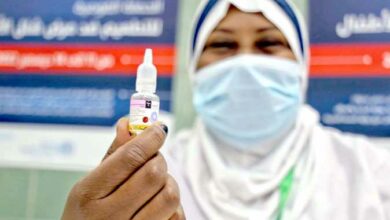Nearly 1,000 striking doctors escalated their protest by forming a human chain from the Doctors Syndicate to the Health Ministry in downtown Cairo on Thursday, while hundreds of political activists joined them in a show of solidarity. But some observers worry that the strike may need a boost in order to press its demands.
The white-coated chain was followed by a march to the Health Ministry. However, riot police had sealed off Maglis al-Shaab Street leading to the ministry, forcing a diversion of the march through side streets to the ministry’s rear entrance.
While the human chain along Qasr al-Aini Street was generally silent, slogans were chanted along the march to the Health Ministry including: “The strike is legitimate against hunger and against poverty,” “We demand a dignified life,” and “What is more important than Egyptians’ health?”
Protesters also chanted slogans denouncing the health minister, Prime Minister Hesham Qandil and President Mohamed Morsy.
Thursday’s protest is the latest move through which striking doctors have demanded that the state’s health budget be raised from 4.8 percent to 15 percent.
Striking doctors are also demanding improved medical facilities and healthcare standards for patients, better working conditions, an incremental pay raise scale for doctors and hospital staff, and the provision of security at hospitals.
On 1 October, thousands of doctors began a nationwide, yet partial, strike. They escalated their action a few weeks later by launching a campaign of mass resignations from the Doctors Syndicate.
Leading board members of the Doctors Syndicate, dominated by the Muslim Brotherhood, have refused to endorse this strike. Many also declined to endorse the previous doctors’ strikes in May 2011 and September 2011. So far, the Health Ministry has dismissed the doctors’ demands.
According to the ministry, this latest strike has detrimentally affected patients and Egyptian healthcare in general. However, striking doctors claim that all emergency rooms are in service — even at hospitals affected by strikes.
Yet the ministry also argues that this latest strike is not widespread. Over 75 percent of public hospitals (394 of them) are fully operating, while only 118 of these hospitals are partially operating, and a mere eight hospitals are on total strike, they say.
Neither Health Minister Mohamed Mostafa Hamed nor his spokesperson could be reached for comment regarding Thursday's protest.
According to Dr. Mona Mina, leader of the doctors’ strike committee and member of the Doctors Without Rights group, “today’s actions were a success” in light of the large turn out of doctors, and the presence of political activists standing in solidarity with their demands. Mina explained that a doctors’ delegation had re-submitted its demands to the Health Ministry today.
Mina added that there was a similar protest staged today by striking doctors in the Nile Delta Governorate of Monufiya.
Regarding the campaigns of mass resignations from the Doctors Syndicate, Mina said, “The resignation campaign is ongoing.”
“A number of media sources have published inaccurate figures regarding these resignations. We have not yet announced the official number of resignations, yet we will do so when the number of resignations reaches 15,000,” she added.
Indeed, media reports have reported conflicting numbers of resignations. Some outlets have claimed dozens of resignations, while another publication has claimed over 5,000.
According to Dr. Hend Adel, a psychiatrist at the Abbasseya Mental Health Hospital, “We are not demanding money from the state right now. We are merely asking for a timetable, for concrete steps in a health plan through which we can realize our demands in the near future. Yet the authorities continue to ignore us.”
Adel went on to comment, “We have been on strike for a whole month now, yet we haven’t received any concessions, or even responses, from the ministry.”
The striking psychiatrist emphasized, “The most important and powerful bases on which to build a country are proper healthcare and education.” Egypt lacks both, according to Adel, while "advanced nations typically allocate over 10 percent of their budgets for healthcare.”
Adel pointed out that Egypt suffers from “terrible health care in public hospitals, a lack of hospital beds, inexperienced medical graduates, corruption within training institutions, expired medication, lack of drugs and medical facilities, and very poor infection-control standards.”
The doctor added that Egyptian doctors suffer from very low incomes at public hospitals. “This leads many doctors to rush through their work at public hospitals so that they may go work their second shift at private clinics — where they make more money.”
“There is a common misconception that doctors are rich and well paid. In reality conditions are quite the opposite.” Adel explained that after four years of employment as a full time doctor, she earns a basic monthly wage of only LE284 plus variable bonuses which may raise her total monthly income to a mere LE800-1,000.
Hundreds of members of the April 6 Youth Movement, the Strong Egypt Party, the Egyptian Federation of Independent Trade Unions, the Revolutionary Socialists, the Communist Party, the Popular Current, the Kefaya Movement, the Constitution Party, and other political groups, along with non-affiliated activists and celebrities, took part in Thursday's protest.
Renowned blogger and political activist Alaa Abd El Fattah said that Thursday’s actions were “successful given the number of non-doctors participating in this action,” but added, “I’m afraid the doctors may be running out of escalatory measures by which to push forth their demands; especially given that the authorities are clearly ignoring all these demands.”
“I’m also afraid that the current regime may push ahead with Mubarak-style privatizations of the healthcare services,” he said.
The activist added that such measures would serve to deny affordable medical treatment for an untold number of poor and low-income patients across the country.




